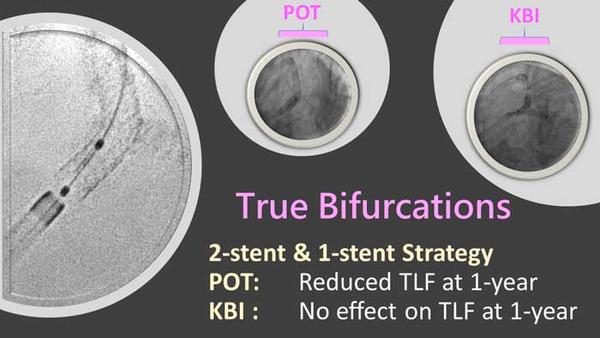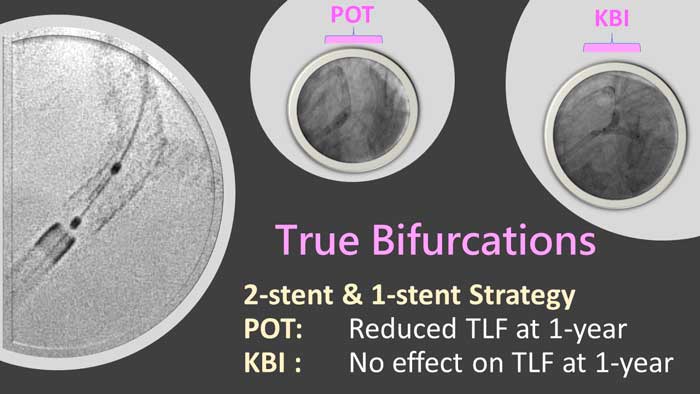Clinical outcomes of proximal optimization technique (POT) in bifurcation stenting
Selected in EuroIntervention by M. Alasnag , K. Al-Shaibi
Find out more about what is considered the largest real-world registry data permitting analysis of very specific steps of bifurcation stenting, POT, and KBI.
References
Authors
Bernard Chevalier, Mamas A Mamas, Thomas Hovasse, Muhammad Rashid, Joan Antoni Gomez, Manuel Pan, Adam Witkowski, James Crowley, Adel Aminian, John McDonald, Farzin Beygui, Javier Fernandez Portales, Ariel Roguin, Goran Stankovic
Reference
10.4244/EIJ-D-20-01393
Published
May 11, 2021
Link
Read the abstractReviewers
Our Comment
Why this study? – the rationale/objective
Bifurcation techniques have evolved significantly over the last decade. Contemporary practice distinguishes between true bifurcations, Medina 1,1,1; 1,0,1; or 0,1,1; and other lesions.
The latest European Bifurcation Club consensus document recommends a stepwise provisional strategy as a default1. The techniques, particularly the two-stent strategies, entail multiple steps that include kissing balloon inflations (KBI) in the main vessel (MV) and side branch (SB), and proximal optimization (POT). Much of the evidence guiding practice has focused on provisional versus two-stent strategy, such as the DK Crush series and the Celtic Trial2-4. Very little evidence was generated on the various technical steps, namely POT and KBI.
Data from the RAIN-CARDIOGROUP VII confirmed that a short overlap final KBI in those treated with a two-stent strategy (including unprotected left main (LM)) was associated with less target vessel revascularization (TVR) and restenosis5. Although this was a contemporary study using latest-generation drug-eluting stents, 67 % were not image-guided and 47 % only underwent POT. However, in another study, Zhong et al noted that KBI reduced the SB restenosis at the expense of an increased MV restenosis in the one-stent approach. Overall, clinical outcomes were similar in those with and without KBI6. This study by Chevalier et al addresses the one-year outcomes of POT from the e-ULTIMASTER global registry7.
How was it executed? – the methodology
The e-ULTIMASTER global registry is a prospective, multicenter, single-arm registry that included patients undergoing bifurcation percutaneous coronary intervention (PCI) between October 2014 and June 2018 in 50 countries. This was an all-comer observational cohort that enrolled different indications, ranging from stable disease to acute coronary syndromes. The analysis used propensity scores calculated by a logistic regression model. Inverse probability of treatment weights propensity score methodology was used to adjust for any baseline differences for the POT vs no POT and KBI vs no KBI groups. The primary outcome was target lesion failure (TLF), defined as a composite of cardiac death, myocardial infarction (MI), and clinically driven target lesion revascularization (TLR) at one year. Secondary outcomes were defined as any death, cardiac death, MI, TLR, TVR, TVF, stent thrombosis, and major bleeding.
What is the main result?
A total of 4,230 patients of the e-ULTIMASTER global registry underwent bifurcation PCI and completed one-year follow-up (11.8 % of the total cohort). 52.2 % were true bifurcations and 68.4 % involved the Left Anterior Descending artery, and only 12.4 % were LM disease. Men constituted 76.5 % of the cohort and the average age was 65.6 years.
At one-year endpoint, TLF rate was 5.1 %. POT was performed in 33.9 % of cases and its use was more prevalent in left main and LAD lesions, as well as in long lesions, true bifurcations, and when a two-stent technique was used.
Benefit was consistent in all subgroups and was reported as early as the first month and sustained throughout the 1-year follow-up. KBI was performed in 36.5 %, with no effect on 1-year composite endpoints of TLF. However, an interaction between KBI and Left Main involvement, Medina type, stent size, and prolonged DAPT use was noted.

Proximal optimization technique was associated with a low event rate in the largest registry of bifurcation stenting. Kissing balloon inflations had less consistent outcomes.
Critical reading and the relevance for clinical practice:
This is considered the largest real-world registry data permitting analysis of very specific steps of bifurcation stenting, POT, and KBI. Such a procedural step-by-step analysis is very limited through smaller randomized data sets. The adjusted propensity scores allow a close examination of this large data set and reconfirm the importance of POT over KBI, even after adjusting for variables.
Although the statistical analysis was robust, several confounders cannot be adjusted for. The most important confounder is the evolution of the KBI technique over the time period of the study. Much less has changed regarding POT over that same time period. Furthermore, the lack of intracoronary imaging (used in only 9.3 % of this cohort) makes ascertainment of appropriate SB wire crossing and hence SB ostial scaffolding in a 2-stent strategy uncertain in a population comprised of 80 % provisional stenting strategy problematic.
The overall event rates of this cohort including stent thrombosis were low. This could partly be a reflection of the low-risk population included with STEMI and NSTEMI accounting for only 12.7 % and 23 % respectively. Baseline Left Ventricular dysfunction was not reported and would add another layer of complexity to the treatment of bifurcation disease. The incidence of diabetes, prior PCI or CABG, and chronic kidney disease in this cohort was low. Chronic total occlusions were only 3.8 %, the number of stents per patient was 1.9, and the length of implanted stents per patient was 36 mm.
LM PCI was under-represented in this registry, and further studies are necessary for concrete conclusions, especially in relation to the need for KBI with LM intervention since the SB is always a critical vessel (LAD or LCX). The nature of registry data makes it difficult to adjudicate the Medina classification for LM PCI, determine whether a 1 or 2-stent strategy was most suitable, and ascertain correct sizing and positioning of the balloon in KBI.
The absence of a core lab makes it difficult to understand how many of these bifurcations were treated with the more recent modifications to the KBI and POT techniques, as well as the additional steps in the 2-stent techniques including an additional POT, and not merely a final POT. The enrollment started in 2014, when many operators performed a single final POT, and DK Culotte was not reported yet.
Finally, differences between the different 2-stent strategies cannot be determined where confounders such as operator experience, and lesion complexity (based on the DEFINITION II Trial) are not reported.
Overall, this study reinforces the value of POT and warrants more detailed evaluation of KBI in light of the information we now know from computational flow dynamics and ultra-computed tomography of SB stenting and recrossing.
References
- Burzotta F, Lassen JF, Lefèvre T, Banning AP, Chatzizisis YS, Johnson TW, Ferenc M, Rathore S, Albiero R, Pan M, Darremont O, Hildick-Smith D, Chieffo A, Zimarino M, Louvard Y, Stankovic G. Percutaneous coronary intervention for bifurcation coronary lesions: the 15th consensus document from the European Bifurcation Club. EuroIntervention. 2021 Mar 19;16(16):1307-1317. doi: 10.4244/EIJ-D-20-00169. PMID: 33074152.
- Chen X, Li X, Zhang JJ, Han Y, Kan J, Chen L, Qiu C, Santoso T, Paiboon C, Kwan TW, Sheiban I, Leon MB, Stone GW, Chen SL; DKCRUSH-V Investigators. 3-Year Outcomes of the DKCRUSH-V Trial Comparing DK Crush With Provisional Stenting for Left Main Bifurcation Lesions. JACC Cardiovasc Interv. 2019 Oct 14;12(19):1927-1937. doi: 10.1016/j.jcin.2019.04.056. Epub 2019 Sep 11. PMID: 31521645.
- Chen SL, Xu B, Han YL, Sheiban I, Zhang JJ, Ye F, Kwan TW, Paiboon C, Zhou YJ, Lv SZ, Dangas GD, Xu YW, Wen SY, Hong L, Zhang RY, Wang HC, Jiang TM, Wang Y, Sansoto T, Chen F, Yuan ZY, Li WM, Leon MB. Clinical Outcome After DK Crush Versus Culotte Stenting of Distal Left Main Bifurcation Lesions: The 3-Year Follow-Up Results of the DKCRUSH-III Study. JACC Cardiovasc Interv. 2015 Aug 24;8(10):1335-1342. doi: 10.1016/j.jcin.2015.05.017. PMID: 26315736.
- Walsh SJ, Hanratty CG, Watkins S, Oldroyd KG, Mulvihill NT, Hensey M, Chase A, Smith D, Cruden N, Spratt JC, Mylotte D, Johnson T, Hill J, Hussein HM, Bogaerts K, Morice MC, Foley DP. Culotte stenting for coronary bifurcation lesions with 2nd and 3rd generation everolimus-eluting stents: the CELTIC Bifurcation Study. EuroIntervention. 2018 Jun 8;14(3):e318-e324. doi: 10.4244/EIJ-D-18-00346. PMID: 29792404.
- Gaido L, D’Ascenzo F, Imori Y, Wojakowski W, Saglietto A, Figini F, Mattesini A, Trabattoni D, Rognoni A, Tomassini F, Bernardi A, Ryan N, Muscoli S, Helft G, De Filippo O, Parma R, De Luca L, Ugo F, Cerrato E, Montefusco A, Pennacchi M, Wanha W, Smolka G, de Lio G, Bruno F, Huczek Z, Boccuzzi G, Cortese B, Capodanno D, Omede P, Mancone M, Nunez-Gil I, Romeo F, Varbella F, Rinaldi M, Escaned J, Conrotto F, Burzotta F, Chieffo A, Perl L, D’Amico M, di Mario C, Sheiban I, Gagnor A, Giammaria M, De Ferrari GM. Impact of Kissing Balloon in Patients Treated With Ultrathin Stents for Left Main Lesions and Bifurcations: An Analysis From the RAIN-CARDIOGROUP VII Study. Circ Cardiovasc Interv 2020;13:e008325.
- Zhong M, Tang B, Zhao Q, Cheng J, Jin Q, Fu S. Should kissing balloon inflation after main vessel stenting be routine in the one-stent approach? A systematic review and meta-analysis of randomized trials. PLoS One 2018;13:e0197580.
- Chevalier B, Mamas MA, Hovasse T, Rashid M, Gómez-Hospital JA, Pan M, Witkowski A, Crowley J, Aminian A, McDonald J, Beygui F, Fernandez Portales J, Roguin A, Stankovic G. Clinical Outcomes of Proximal Optimization Technique (POT) in Bifurcation Stenting. EuroIntervention. 2021 May 11:EIJ-D-20-01393. doi: 10.4244/EIJ-D-20-01393. Epub ahead of print. PMID: 33970107.







No comments yet!